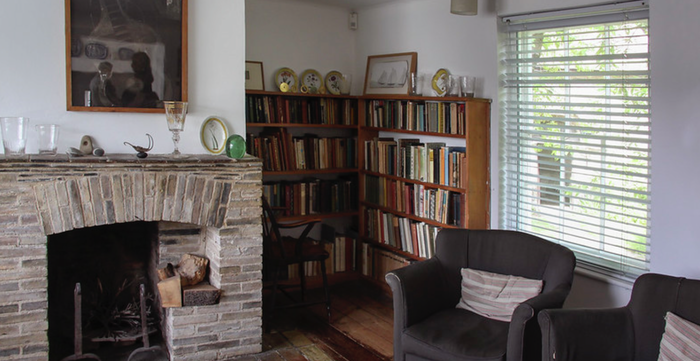Fen Ditton Gallery’s print exhibition is a hidden gem
Isabel Dempsey takes a rainy walk to review Fen Ditton Gallery’s latest printmaking exhibition, finding it to be a cosy hidden treasure trove well worth the trek

Deciding to visit Fen Ditton Gallery in the middle of a blizzard probably wasn’t the wisest decision on my part. Fighting the cutting winds and horizontal streams of snow to a mysterious bus-stop near Christ’s, my confidence in my Google-Maps-approved timetable was waning. Eventually arriving at the gallery, umbrella just about still intact and hair somewhere within the socially acceptable sphere of scraggliness, I soon found my perilous adventure had been well worth it.
“The art you print out on A4 paper will never be a true version of the art itself”
A cosy cup of tea now in hand, I was welcomed inside the homely interior of Fen Ditton Gallery, the walls boldly decorated with the 40 short-listed entries of the gallery’s recent printmaking competition. Coming out on top from an impressive 600 applicants, the eye-catching winner now took centre stage in all its surreal red glory. The piece in question, Deep Within by Amber Jesson, was created by a process called photogravure etching. Clearly noting my confusion, the gallery’s manager, Hannah Munby, tells me how Jesson used a pinhole camera on walks around sacred sites in the Peak District to create her piece. Embracing the “restorative power” of walking, she used her medium to blur between the “seen and the unseen”, exploring ideas of femininity in the “womb-like vessel” the pinhole camera creates.
Although fascinated by the intricate and barely-understood-by-me process of using a photopolymer etching plate (big words, I know) I was even more amazed to learn how little information the judging panel were given about the process of its creation. The panel in question consisted of Sir Richard Heaton (Warden of Robinson College and art enthusiast), master printmaker Kip Gresham, and Fitzwilliam Museum curator Elenor Ling. Together they covered the realms of visual, technical and historical print appreciation as well as rooting the competition firmly in Cambridge’s printing-rich history, with the Fitzwilliam housing the UK’s second largest print collection. And yet, however much their knowledge might have allowed them to take a good guess at the printing processes used, ultimately the visual impact and technique of the final product was what made its mark – little printing pun for you there.
“Printing has grown far beyond mere production to a creative representation of meaning”
Pressing Matters (a print publication about printing) also chose a winner of its own, opting to award Rachel Gracey’s Following Marston Brook the top spot. With the piece’s interest in the texture and “transient features” of nature, it seemed beautifully fitting that it was created by stone lithography, physically attaching the natural environment to her depiction of the natural world. Much like Jesson’s womb-like camera box, the chosen mode of printing once again demonstrates its necessity to the meaning. Although printing as an artform historically drew traction in allowing an artist to produce, sell and distribute more than one version of their work to a wider market, the many long and confusing words I found amongst the list of works (from lithograph to collograph and terms I can’t even remember) proves that printing has grown far beyond mere production to a creative representation of meaning.
As Hannah points out, just because these are prints doesn’t make them any less valuable. With all the prints in the competition made within the last four years, there is only a limited edition of each, with some being the only version of the print to exist. Even if they are all replicas, no print is ever the exact same as another, and hours and hours of dedicated hand-craftsmanship are still essential to the creation of any one edition. Hannah tells me that the captivating and busily-peopled scene of Daniel Howden’s Monolith II, for example, consisted of printing 442 registrations for each edition. This meant that he “rose out of my chair, picked up a print, rolled ink, held my breath and applied pressure around 3978” times, for just nine artworks.
Reflecting on the competition, printmaker Kip Gresham commented “it’s great to see printmaking alive and well”. In a world of mass-produced inkjet printing, where paintings can be reproduced at the press of a button, print culture is increasingly becoming an endangered species. However no inkjet printer can reproduce the texture, meaning and craft behind these works; the art you print out on A4 paper will never be a true version of the art itself. If you’d asked me a couple of weeks ago to persuade you to go and see an exhibit about printmaking so far from walking distance from my college, I might have struggled. But one essay about William Blake’s printing process and this eye-opening exhibition later I have developed a newfound fascination for the intricacies of this so little talked of craft. If I can trek all the way there from Robinson in a blizzard and still find my journey to be well worth it, then you really have no excuse not to pop over to Fen Ditton to explore this cosy little gallery yourself.
 News / Uni Scout and Guide Club affirms trans inclusion 12 December 2025
News / Uni Scout and Guide Club affirms trans inclusion 12 December 2025 News / Pembroke to convert listed office building into accom9 December 2025
News / Pembroke to convert listed office building into accom9 December 2025 News / Cambridge Vet School gets lifeline year to stay accredited28 November 2025
News / Cambridge Vet School gets lifeline year to stay accredited28 November 2025 Features / Searching for community in queer Cambridge10 December 2025
Features / Searching for community in queer Cambridge10 December 2025 News / Uni redundancy consultation ‘falls short of legal duties’, unions say6 December 2025
News / Uni redundancy consultation ‘falls short of legal duties’, unions say6 December 2025









